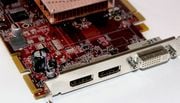
There are only a select few events in the PC hardware world that get hardcore enthusiasts truly excited. For example, when popular trade shows like Computex, IDF, and CES take place, there is a fair amount of buzz. Also, anytime the major players in graphics release next-generation GPUs, things definitely heat up; or likewise when a hot new game hits. Finally, when either of the processor big guns, Intel or AMD unleash new CPU micro-architectures on the world, you can almost bet on the community to come alive with enthusiasm. We're sure we've missed a few other momentous occasions as well, but you get the gist. It takes something new and exciting to get a PC Enthusiast's pulse racing.
Thankfully, today is one of those times. Although Intel won't be officially launching their Core i7 processors, formerly codenamed Nehalem, and the X58 Express chipset until sometime later in the month, we've had them in house for a while now and can finally show you all the goods. We've tested every Core i7 speed grade that will be available at launch, along with at trio of X58 Express based motherboards. We've even thrown in some high-resolution multi-GPU SLI and CrossFireX testing for good measure as well.
Specifications & Features
•Core Frequencies - 3.2GHz (965), 2.93GHz (940), 2.66 (920)
•QPI Speed - 6.4GT/s (965), 4.8GT/s (940, 920)
•TDP (Thermal Design Power) - 130W
•Stepping - 4
•Number of CPU Cores - 4
•Shared L3 Cache - 8MB
•L2 Cache - 1MB (256K x 4)
•Processor input voltage (VID) - 1.160v
•.045-micron manufacturing process
•Shared Smart Cache Technology
•PECI Enabled
•Enhanced Intel SpeedStep Technology (EIST)
•Extended HALT State (C1E) Enabled
•Execute Disable Bit (XD) Enabled
•Intel 64 Technology
•Intel Virtualization Technology (VT)
•Packaging - Flip Chip LGA1366
•Total Die Size: Approximately 263mm2
•Approximately 731M Transistors
•MSRP - $999 (965), $562 (940), $284 (920)
Intel's Core i7 Processor
Six, Tuesday, September 1, 2009Display ATi RV635 XT
Six,
The Video Electronics Standards Association (VESA) unveils a new interface dubbed Display port which will supplant DVI and VGA connections eventually and its micropacket architecture offers significantly more bandwidth with multi-monitor support over a single cable. Like HDMI, a DisplayPort connection can carry 8-channel 24-bit audio, but also offers a dedicated auxiliary link for control communications of things like panel I/O and microphone connections. There are hundreds of big brand name companies behind the standard that is set to compete with HDMI for desktop and notebook dominance, including the likes of AMD, Intel, NVIDIA, Samsung and Dell. However, DisplayPort is more likely to co-exist with HDMI, since HDMI is specifically targeted for consumer electronics like set-top boxes, DVD players etc, while DisplayPort was designed from the ground up for computing.
ATI's RV635 XT board is beeing testing it out on an unreleased LCD panel that we'll be showing you in the coming weeks. On the board you'll note that the surrounding circuitry for each DisplayPort connection is minimal and devoid of those all-too familiar Silicon Image TMDS chips that add cost to any dual link DVI-D connection. Since each DisplayPort cable can run multiple monitors in a daisy-chain configuration, imagine a four panel setup from a single graphics card and even possibly a single cable connection!!!!
We've got an RV635 XT board here and have been testing it out on an unreleased LCD panel that we'll be showing you in the coming weeks. On the board you'll note that the surrounding circuitry for each DisplayPort connection is minimal and devoid of those all-too familiar Silicon Image TMDS chips that add cost to any dual link DVI-D connection. Since each DisplayPort cable can run multiple monitors in a daisy-chain configuration, imagine a four panel setup from a single graphics card and even possibly a single cable connection. We'll have more to come on the LCD side of the equation, soon.










